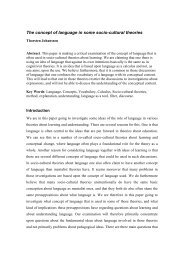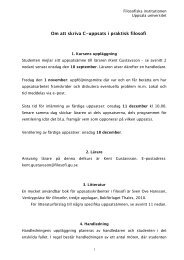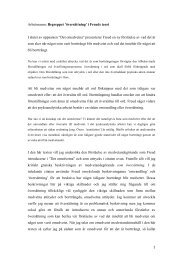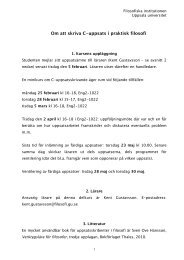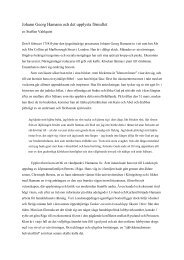1 Dewey, Wittgenstein, and Linguistic Instrumentalism My paper ...
1 Dewey, Wittgenstein, and Linguistic Instrumentalism My paper ...
1 Dewey, Wittgenstein, and Linguistic Instrumentalism My paper ...
You also want an ePaper? Increase the reach of your titles
YUMPU automatically turns print PDFs into web optimized ePapers that Google loves.
“language is primarily a mode of action” (LW 1: 160). <strong>Dewey</strong> means social action of<br />
which teaching is a fine example. Elsewhere, <strong>Wittgenstein</strong> writes, “words are deeds”<br />
(CV 46). The word “deed” is especially cordial for pragmatists (pragma in ancient Greek<br />
meant “deed”). Below, I will use words like action, activity, deed, operation, <strong>and</strong><br />
practice interchangeably with behavior. 11<br />
<strong>Wittgenstein</strong> <strong>and</strong> <strong>Dewey</strong> (Heidegger as well) assert the primacy of social practice<br />
as the context for linguistic practice. <strong>Wittgenstein</strong> maintains that “the term ‘language-<br />
game’ is meant to bring into prom inence the fact that the speaking of language is part of<br />
an activity, or of a form of life” (PI § 23). Meanwhile, <strong>Dewey</strong> insists, “we have to be able<br />
to re-state the whole social context which alone supplies the meaning” (LW 1: 160).<br />
Most philosophers are familiar with what we might call the builders' language-game<br />
early in the Investigations. In this game, language enables communication between a<br />
builder A <strong>and</strong> an assistant B. They are building with blocks, pillars, slabs, <strong>and</strong> beams. B<br />
has to pass the materials in the order in which A needs them (PI § 2). One possible<br />
move in this game involves the request: “Bring me a slab” (PI § 19 ff.). Now compare<br />
<strong>Wittgenstein</strong>’s slab game to the following example of what we might call <strong>Dewey</strong>’s<br />
flower game:<br />
A requests B to bring him something, to which A points, say a flower. There is an<br />
original mechanism by which B may react to A's movement in pointing. But<br />
natively such a reaction is to the movement, not to the pointing, not to the object<br />
pointed out. But B learns that the movement is a pointing; he responds to it not in<br />
itself, but as an index of something else. His response is transferred from A's<br />
10




